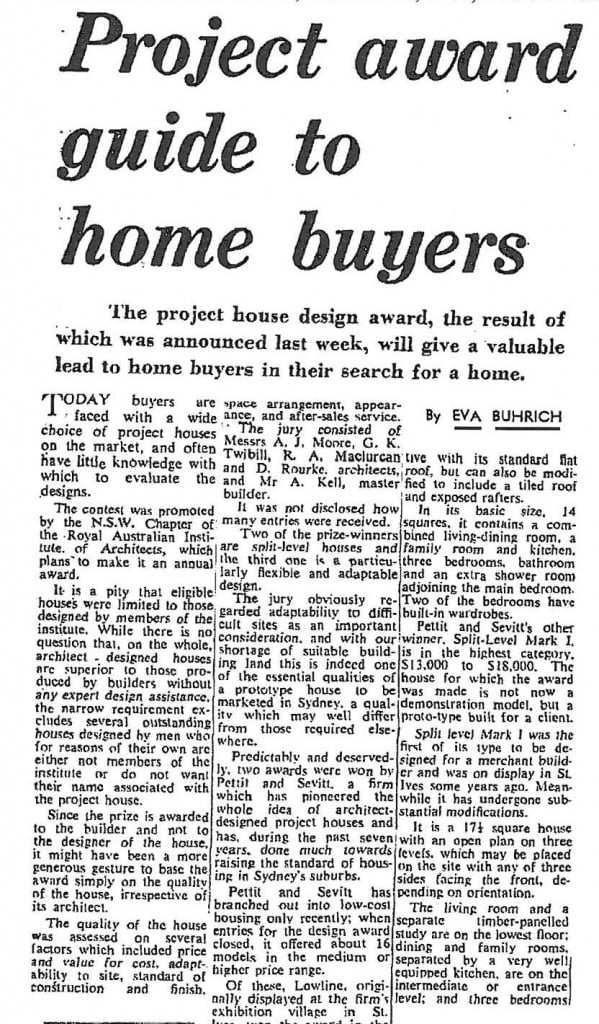Laura Harding talks about not being registered, the importance of mentors and the example of Eva Burich, arguing that we must work diligently to broaden mainstream architectural culture – and what is valued and recognised – if the profession is to be viable and relevant.

Issues of gender equity in any profession are thorny and difficult, because it very difficult to know how to relate the details of one’s own experience to the broader trends that are reported. It is hard to determine whether your negative experiences are the result of gender politics, or simply the random result of the particular range of people you have encountered in your working life.
I found my early working years to be refreshingly free of any concern about unequal treatment or opportunity. Perhaps this is due to there being very little at stake when one is young and starting out – but I prefer to view this more positively, as being due to some of the smartest older women I have had the good fortune to work with. The negative experiences of my working life are trivial in comparison to the stories that are related by this small, but treasured group of mentors. I see this as evidence that their strength, resilience and defiance have changed the workplace – slowly, but lastingly.
Some of my expectations about gender issues were confounded early. I always expected that the battleground for women’s issues in architecture would be the building site. In practice, I have been tested, but always treated with respect on building sites. I cannot say the same for the corporate boardrooms I have encountered, where the most negative aspects of corporate, masculine culture are dutifully camouflaged; and this has served only to lengthen its shelf life.
I have worked almost exclusively in one practice for 16 years, where three of the four employed senior staff are women who have worked at the practice for more than a decade. Not one of us is formally registered as an architect, and it was not until reading Dr Karen Burn’s article that I ever stopped to consider why, or thought that this might serve to make us invisible in our profession. Of the three of us, two have children, one doesn’t. One had her children very early, while studying – the other had her children later, after she had embarked on her career as an architect.
On reflection – I think our lack of formal accreditation has little to do with gender, and a lot to do with the very limited nature of what is valued and elevated in architecture. The registration process values familiarity with a very particular mode of practice of project procurement. Our work has seen us complete very little work of this nature. Between us, we’ve undertaken a large amount of urban design work and multiple housing projects at the mid range of the economic market. It just happens that this is not the sort of work that leads to familiarisation with the skill set that is tested in the registration process.
We do this work because it is a strong fit for the architectural, social and civic ideals that we hold. It is why we have stayed, and I think perhaps why registration has never become a pressing concern. I’ve never had a client ask me why I am not registered, but one did have a good laugh when he saw that the ‘layperson’ working on his project was on the jury for the state awards. The only people who ever ask about my formal credentials are architects. Everywhere else, it is the work, not the person, that is the focus.
The definite limits imposed on what is deemed worthy and relevant in architecture are curious. I understand the desire to elevate what is considered to be the most skilled and refined sort of work and to set high standards – but the world itself is a more nuanced place. Architects so narrowly limit what is of value at their peril. If we exclude that which is imperfect, less strident and more humble, we exclude most of the city, and most of society in it. We have ceded almost all of this territory already, with catastrophic results for both.
- SMH, 27 Feb, 1968.
- SMH, 18 July, 1967.
- SMH, 16 July, 1968.
After the third time I was told that I really shouldn’t write for Houses magazine – as it was domestic in focus, and not the sort of thing one should write for if you want to establish yourself as a serious architectural critic – I sought out some writings by Eva Buhrich. Eva was an architect, and the wife of Hugh Buhrich, himself an extraordinary artist who fell outside of what his colleagues considered to be the definition of ‘architect’. I had heard about Eva’s writings every now and then, but set out to find them, with the help of some queries to Bronwyn Hanna, prompted by a reference in her Dictionary of Sydney entry. Eva wrote for an extraordinarily broad collection of journals, trade and women’s magazines. It seems to me that she wrote wherever she could, to reach as broad an audience as possible. Her most consistent output was a column that she penned for the Sydney Morning Herald from the late 50s to the early 70s. I have spent the last months reading through this body of work.
Barely any of the subjects of her writing would fit the very narrow definition of what is considered to be architecture today. Eva wrote repeatedly about housing for the masses. She must have visited every project home display village that was constructed during the life of her column and analysed it for its functionality, its fitness for the purpose of housing and celebrating family life and its value for money. Through her writings I discovered that there used to be an Architecture Award for Project Homes – although Eva was very critical that this was only open to registered architects!
It is uplifting to have made contact with this body of writing. I can’t help but think that if there were someone willing to diligently and persistently interrogate housing, in the accessible and engaging manner that Eva did, in the pages of the state broadsheet every week – that the decisions that we, as a society, make about our housing today might be different. Eva worked diligently to make the concerns of architecture ever broader. It wasn’t heroic, career building work – but it was paid architectural work, and it mattered.
The many quiet, unacknowledged contributions like Eva’s tell me that we must not shy away from the modes of practice that we consider to be engaging and important simply because they are not yet valued by mainstream architecture culture. We must work patiently and diligently to broaden that culture.
We must widen our scope of work, what and who we celebrate, who we talk to and who we allow to contribute; male and female. Limiting our scope has reduced our engagement in society, our voice, the profitability and critical weight of our profession. We have all become the more impoverished for it.


























1 comment
Louie5 says:
Jun 12, 2013
Very nice essay Laura. Come visit me in China.!!